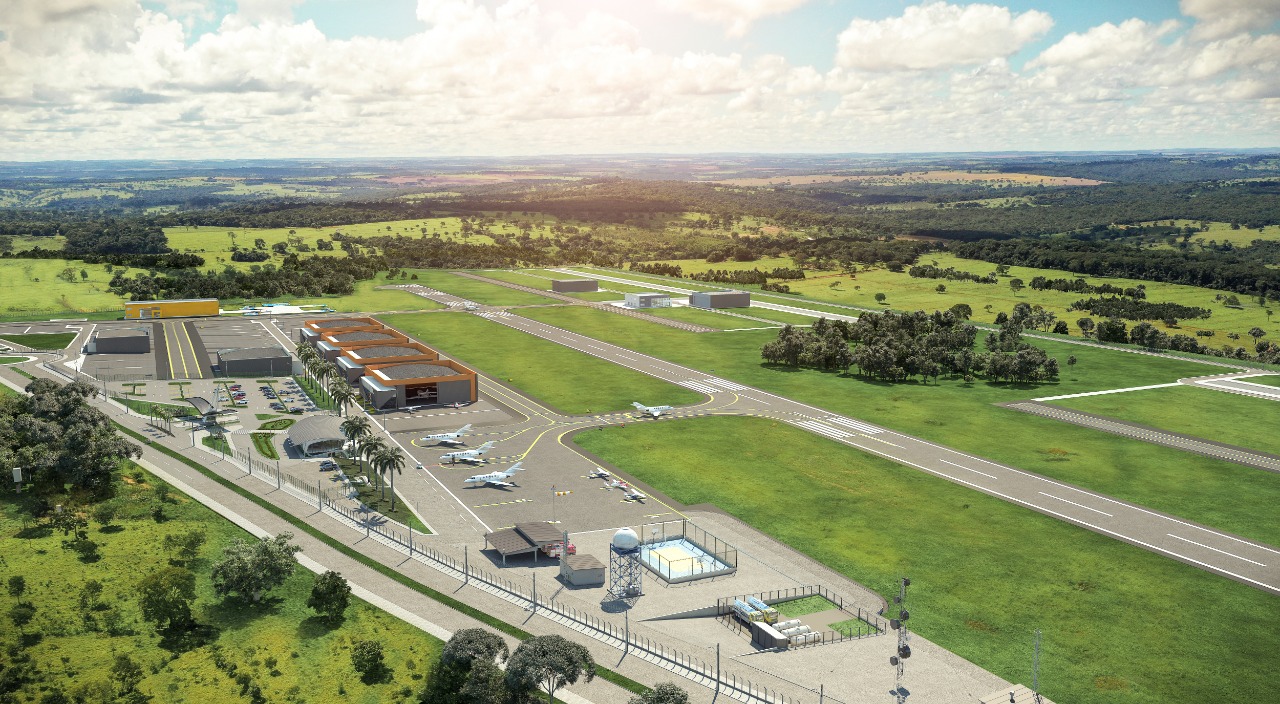Brazilian Aviation Closes 2022 with an Increase in the Number of Flights and Jet Fleet

Rendered image © Antares Polo Aeronáutico - Disclosure.
Brazilian aviation registered a monthly average of 30,000 landings and takeoffs of executive flights until October 2022, according to the most recent report by the Brazilian Association of General Aviation (ABAG). The number represents a 15% increase in relation to the rates registered in the same month in 2019, pre-pandemic period, and 40% more in relation to 2020. There is also an expectation that the movement of general aviation in 2022, with 315 operations until October, surpass the 350,000 landings and takeoffs for the entire year of 2021.
The good numbers don't stop there. In business aviation, for
the third consecutive year, the private jet fleet in the country has increased:
in 2020 there were 688 aircraft of this type operating, in 2021 it increased to
728 and by October 2022 there were 780 jets in operation. A promising panorama
like this, in addition to demonstrating a greater demand for operations within
general aviation, also leverages large private investments in infrastructure
for the sector.
For businessman Rodrigo Neiva, there are several factors
that have led to this increase in the number of flight operations within
executive aviation. “Businessmen and personalities who flee the crowding at
public airports, or who are looking for more flexible schedules and routes not
served by large airlines. In recent years, there has also been a greater demand
for specialized air services such as ICU areas or even a greater use of air as
a more efficient way of transporting cargo”, points out Neiva, who is
commercial director of Antares Polo Aeronáutico, a modern executive airport
under construction in Aparecida de Goiânia, in the metropolitan region of
Goiânia.
With an investment of BRL 100 million, the venture will have
its first stage, of 5, delivered in 2024. The new airport promises to absorb a
large part of the executive flight operations in the Midwest, the Brazilian
region that has the second largest fleet of private aircraft .
A businessman with extensive experience in the real estate
development sector and an aviation enthusiast, Rodrigo Neiva explains that
Antares will be more than an airport that will receive executive flights. “We
will be an aeronautical hub that will be fully capable of hosting logistics and
air cargo transport companies, large industries, aircraft maintenance
companies, pilot training schools, aircraft assemblers and parts manufacturers,
aeromedical services and regional aviation operations” , explains.
Rodrigo Neiva says that executive aviation in Brazil offers
a vast path of business opportunities. “It is important to remember that 90% of
our national aircraft fleet belongs to general aviation and more than 4,000
take-off and landing points in Brazil belong to business aviation, against just
over 100 commercial airports. Even so, executive or general aviation plays a
complementary role to the market work of large airlines”, clarifies the
businessman, remembering that of the more than 5,500 Brazilian municipalities,
only 130 receive commercial flights, the rest depend on other modes of
transport or of general aviation.
About Antares
Occupying a total area of 2 million m², of which 650
thousand square meters (m²) will be dedicated to the construction of hangars,
Antares is a project led by a consortium formed by the companies Tropical
Urbanismo, Innovar Construtora, CMC Engenharia, BCI Empreendimentos and Participações
and RC Bastos Participações.
In its first phase, the aeronautical hub will deliver 72
lots from 1,000 m² to 1,500 m², equipped with complete infrastructure with
streets, sidewalks, networks for electricity, water and internet. This first
stage of the project will also have a passenger terminal, parking lot and a
runway that will be able to receive even large aircraft, such as a Boeing 737
800.
Privilegedly located in the heart of Brazil, the
aeronautical hub is less than 1,000 kilometers away from cities such as São
Paulo and Belo Horizonte; it is also 1,500 km from Salvador and 1,200 km from
Rio de Janeiro, which are two of the main coastal capitals in the country; and
it is still less than 2,000 km from other capitals, such as Belém (in the North
of the country) and Porto Alegre (in the South).
*DISCLAMER:
The aviation news website MAIS QUE VOAR (MORE THAN FLY) does
not agree with Fakenews. This publication contains content with sources from
press.
This publication was written in Portuguese (Brazil) and
automatically translated by Google robots to English. MORE THAN FLY, adopted
Google technology for everyone around the world to have access to information
and optimize our time and budget with translations. We ask for common sense to
take into account translation errors. After all, every robot is limited and is
never compared to the superiority of a human intelligence.



Nenhum comentário:
Postar um comentário